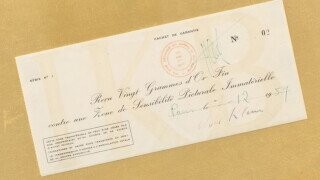’50s People Bought Receipts For Art That (They Knew) Didn’t Exist

For a while this year, the big topic was NFTs, digital receipts often associated with amateurish art. NFTs skyrocketed in value to great fanfare, and then quietly plummeted in value—or stayed still in value because people stopped trading that particular NFT at all, which left the owner even more screwed than if it plummeted.
Though they were always very stupid, NFTs attracted one criticism that wasn’t valid. Critics said anyone could simply grab the image (of a cartoon ape or whatever) by copying it, even without buying the NFT. That’s true, but access to the image was never the point of NFTs. The point was having that receipt, which could change in value and be traded, separate from the art. And the trade of art receipts has its own long history.
In 1958, French artist Yves Klein invited fans to come to a new exhibition of his, in which he exhibited nothing. He called it “The Void.” The gallery was empty. Sure, why not—anything can be art, right? Then he offered to sell people the sort of art he’d exhibited. He’d sell you your own “imaginary space,” something that did not exist.
Don't Miss
The price of an imaginary space? No fixed price, it seemed, but you had to pay it in pure gold. Klein would use this gold in a later sculpture. He issued receipts for these purchases, but he also offered another step. You could burn your receipt, in a ritual. If you chose this route, he would dump half the gold in the Seine, and you would become the true owner of the artwork. This might sound like it makes even less sense than the original sale, but we were already at a base level of zero sense, so no one should object to further levels of abstraction.
Not everyone went for the fire and water ritual. One of those receipts survived and made its way to Sotheby’s this year, where it sold for $1.2 million. The private European collector bought ownership of a 63-year-old nonentity. On the other hand, they also bought a physical piece of paper so they did end up owning something unambiguously. The final label of madness should have been someone creating an NFT of the paper, intangible ownership of ownership of nothing.
This fact came from the One Cracked Fact newsletter. Want more like this, straight from your email inbox, without any ads or popups? Join here:
For more on Klein and imaginary art, check out:
Yves Klein's "Blue" Was An Entirely Unique Invention
Huge, Intricate Sand Patterns That Don't Even Last a Day
Top image: Sotheby’s
